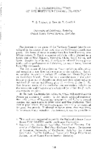- DSpace Home
- →
- Channel Islands
- →
- National Park Service
- →
- California Islands Symposia Documents
- →
- 1st Symposium on the Biology of the California Islands
JavaScript is disabled for your browser. Some features of this site may not work without it.
| dc.contributor.author | Linhart, Yan B. | en |
| dc.contributor.author | Burr, B. | en |
| dc.contributor.author | Conkle, M. T. | en |
| dc.date.accessioned | 2010-01-20T18:08:31Z | en |
| dc.date.available | 2010-01-20T18:08:31Z | en |
| dc.date.issued | 1965 | en |
| dc.identifier.citation | Linhart, Y. B., B. Burr, and M. T. Conkle. "The Closed-Cone Pines of the Northern Channel Islands." In: 1st Symposium on the Biology of the California Islands. National Park Service, 1965. 151-177. | en |
| dc.identifier.uri | http://hdl.handle.net/10139/885 | en |
| dc.description.abstract | Our interest in the pines of the Northern Channel Islands developed in the course of our work with the California closed-cone pines. The focus of these investigations has been Monterey pine (Pinus radiata D. Don.), a species which is widely planted as a forest tree in New Zealand, Australia, Chile, South Africa, and Spain. Despite its wide use, P. radiata is not well known genetically and its performance in California, its native home, has not been fully assessed. The first phase of the project on Pinus radiata entailed study and sampling of the three native stands on the mainland. Later, we sampled its southern variety {P. radiata var. binata Engelm.) on Guadalupe Island. This led to a consideration of the other insular populations of closed-cone pines and their relationship to mainland P. radiata and Bishop pine (P. muricata D. Don.). We thus became aware of the confusion and uncertainty relative to the taxonomic and biosystematic relationships within the P. radiata-muricata complex. In the past, California has relied on virgin and second-growth forests as a source of timber. In the future, artificial regeneration will become of increasing importance, and hitherto unused species may gain status as prime wood and fiber producers. Most insular populations of closed-cone pines occur on sites marginal for good tree growth. If planted on better sites, they may prove to be economically valuable. Furthermore, it may be possible to combine their ability to survive on poor sites with the fast-growth characteristics of other species or populations to produce strains suitable for wood production in less-than-optimal situations. The hybrid Pinus attenuata X P. radiata is a good example of the above possibility, combining the drought and cold resistance of knob-cone pine (P. attenuata Lemmon) with the fast growth of P. radiata. Such economic considerations, in addition to the biosystematic problems cited above, led us to study and sample the closed-cone pine populations on Guadalupe Island in February 1963. Cedros Island in April 1963, Santa Cruz Island in June 1964. and Santa Rosa Island in April 1965. This paper contains descriptions of the populations of closed-cone pines on Santa Cruz and Santa Rosa islands, and analyses of data from specimens collected on these islands as well as related mainland populations of Pinus muricata. Our results and observations are then discussed in the light of present knowledge of the California closed-cone pines. | en |
| dc.language.iso | en_US | en |
| dc.publisher | National Park Service | en |
| dc.subject | Monterey pine | en |
| dc.subject | Channel Islands | en |
| dc.subject | California Islands | en |
| dc.subject | tree genetics | en |
| dc.subject | closed-cone pines | en |
| dc.title | The Closed-Cone Pines of the Northern Channel Islands | en |
| dc.type | Article | en |

